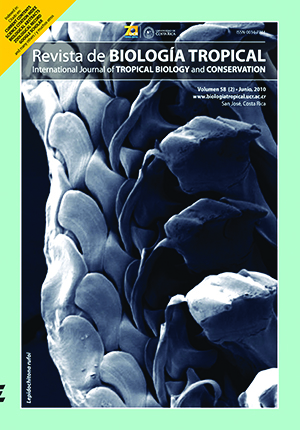Abstract
Anopheles aquasalis Curry is considered the main vector of human malaria in Northern Venezuela. A longitudinal study was carried out in the coastal areas of the Paria Peninsula, Sucre state. The larval habitats of A. aquasalis were classified as: 1-Brackish mangrove, and 2- Freshwater herbaceous swamp. Field surveys of mosquito larvae and aquatic insects were carried out in the same breeding sites over a one-year period, between January and December 1999. At each site, 30 samples of Anopheles larvae and aquatic insects were taken monthly. Simultaneously with mosquito larvae sampling, five selected variables of water were measured: conductivity, salinity, dissolved oxygen, temperature and pH. Seasonal and temporal variations of A. aquasalis larvae and aquatic insects were determined in the two larval habitats. For the entire study period, the abundance of larvaewas higher in the mangrove. Correspondence analysis showed a strong relation between some chemical factors of water and larval abundance. The abundance of A. aquasalis larvae in both seasons, was positively correlated with water salinity, pH and conductivity, and negatively and with dis-solved oxygen in the dry season. The presence of larvae was positively correlated with the presence of Avicenia germinans. In the mangrove there was a positive association between larvae abundance and Scirtidae family abundance and a negative correlation between larvae abundance and monthly precipitation (Spearman), as well as a significant negative correlation between Gerridae abundance and monthly precipitation. In the herbaceous swamp, there were not significant associations between A. aquasalis larvae abundance and abundance of others aquatic insects associated to habitat.
##plugins.facebook.comentarios##

This work is licensed under a Creative Commons Attribution 4.0 International License.
Copyright (c) 2010 Revista de Biología Tropical






